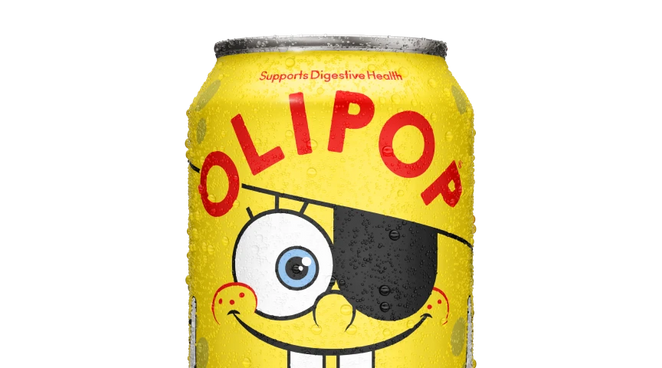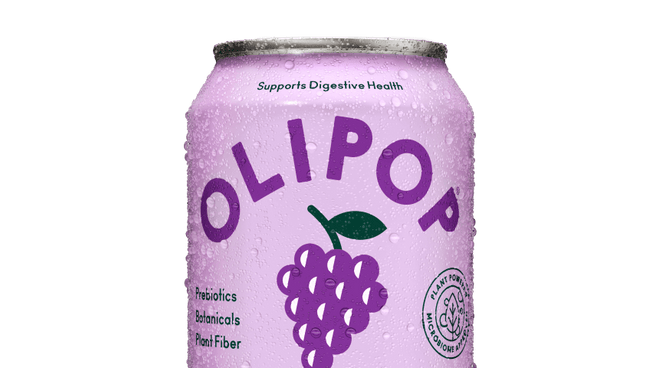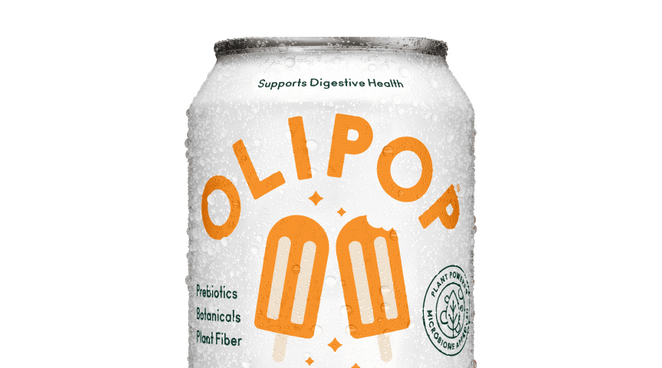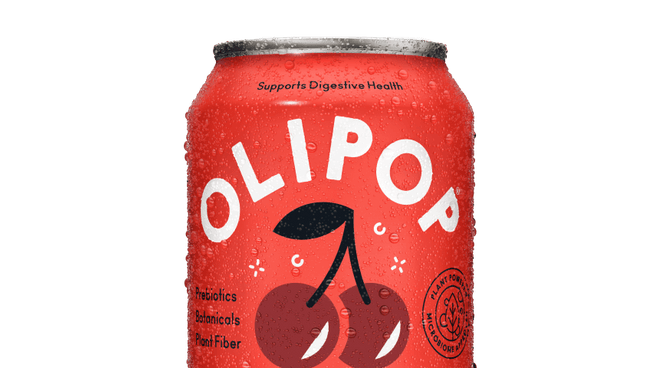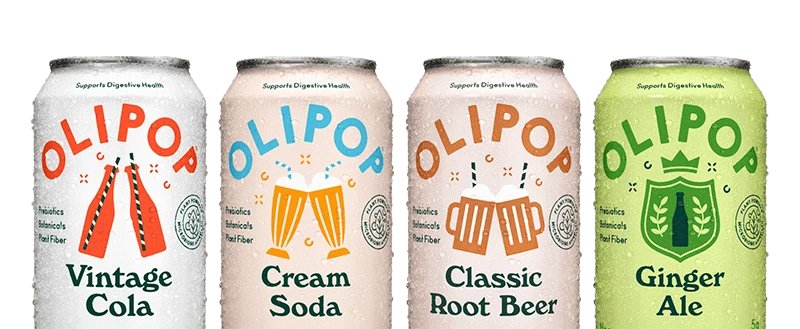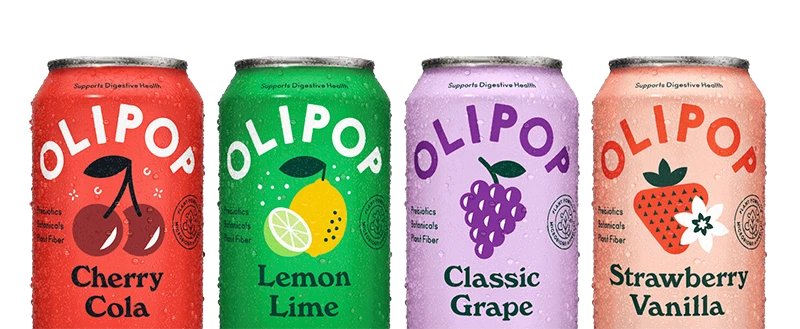Sure, we all love the fizzy satisfaction of cracking open a can or bottle of cold soda. But have you ever stopped to think about what happens to all those cans and soda bottles once we’re done sipping? In a world where convenience often takes precedence over sustainability, it's crucial to take a closer look at the everyday choices we make and their far-reaching consequences. And that includes the environmental impacts of plastic bottles, aluminum cans, and glass containers that house your favorite thirst-quenching sodas.
Join us this Earth Day as we unpack the implications of soda packaging, exploring the materials, production processes, and disposal methods that contribute to our planet's well-being, or its degradation. We'll also dive deep into the world of sustainability and how we, at OLIPOP, are committed to making a difference. Let’s get started.
Environmental Considerations with Soda Packaging
Soda packaging has an impact on the environment, and it goes beyond just the materials used. The entire life cycle of packaging, from production to transportation to disposal, plays a role. But, as we’ll cover, some materials are worse than others. Hint: we’re looking at you single-use plastic! Buckle up as we unravel a few key aspects you need to know:
- Energy & Resource Use: The extraction, processing, and transportation of raw materials like petroleum for plastics requires the use of significant energy and resources. Aluminum, on the other hand, is infinitely recyclable. That’s why we use it instead of plastic at OLIPOP. But more on that later!
- Harmful Emissions: The production of glass and plastic releases more phosphates and sulfur dioxide into the air than other materials like aluminum. This can pollute our water systems, cause acid rain, and contribute to higher levels of global warming.[1] [2] GHG emissions associated with aluminum cans, on the other hand, are the lowest they can be for a single-use carbonated beverage.
- Transportation: Soda products are often transported over long distances, contributing to carbon emissions. That’s why at OLIPOP we use lightweight aluminum cans, consider greener shipping routes, and source locally whenever we can.
- Recycling Challenges: You can recycle most soda bottles and cans, which reduces their environmental impact. However, recycling rates vary widely, and many containers still end up in landfills, scattered around the earth, or in our oceans as litter. However, aluminum has the highest recycling rate of any single-use item, which is why nearly 75% of all aluminum produced is still in use today.[12]
- Environmental Waste: The improper disposal of plastic bottles contributes to pollution in our oceans and waterways. Plastic packaging can take hundreds of years to degrade. In the meantime, these approximately 171 trillion plastic particles floating around in the ocean are causing major harm to wildlife and our ecosystems.[3] We’ve even found microplastics in human breast milk![4]
Types of Soda Packaging: Plastic vs. Glass vs. Aluminum
But not all soda packaging is the same. Plastic bottles, glass containers, and aluminum cans each have their own environmental challenges. Let’s break down how the environmental impacts above vary depending on the type of packaging used:
Plastic Bottles
Many sodas are sold in PET (polyethylene terephthalate) plastic bottles. These plastic bottles are lightweight, durable, and cheap, making them an ideal choice for soda brands. But it won’t come as much of a surprise that plastic can be pretty harmful to the environment. Here are a few reasons why:
- Toxic Chemicals: Some plastics used in bottle production may contain or leach harmful chemicals, such as phthalates and bisphenol A (BPA). These can have negative health effects.
- Fossil Fuel Production: The production of plastic bottles requires the extraction of petroleum or natural gas to obtain raw materials, such as polyethylene terephthalate (PET). These fossil fuels contribute to greenhouse gas emissions. As of 2020, the U.S. plastics industry is responsible for over 232 million tons of CO2 emissions per year.[5]
- Plastic Pollution: Plastic can take nearly 500 years to decompose. This is a major problem when you consider that in 2021 the beverage industry generated around 600 billion plastic bottles.[6] This resulted in over 25 million tons of plastic waste that will still be hanging around 4 to 5 generations from now.[7]
- Single-Use Products: Recycling rates for plastic bottles are generally low, especially with the growth of single-use plastic products. As a result, only 15% of all plastic bottles make it to a recycling center.[7] Some estimates put that number even lower, saying only 9% of plastics get recycled.[3]
- Recycling Limitations: Even if you do recycle that soda bottle, the outlook still isn’t great. Unlike glass or aluminum, plastic cannot be endlessly recycled. Every time plastic goes through the recycling process, its molecular chains get shorter. Eventually, plastic reaches a point where it can no longer be recycled. This means that all plastic eventually ends up in our landfills or pollutes our environment.[1] [2]
- Harmful Microparticles: But it’s not just plastic bottles floating in the ocean that we have to be concerned about. That plastic breaks down into harmful microparticles called microplastics that pollute our oceans, harm wildlife, and eventually make their way into our own food and drinking water.[2] [7] According to the United Nations, the average human ingests a credit card's worth of plastic waste each week.[8]
- Chemical Recycling: But what about incineration? Burning plastics is a method of managing our overwhelming plastic waste. Processes called “chemical recycling” or “advanced recycling” aim to change the chemical composition of plastic bottles to turn them into burnable fuel. Although this gets rid of the plastic, it also releases an estimated 15 million tons of greenhouse gases every year.[5]
Plastic soda bottles heavily contribute to habitat disruption, ecosystem degradation, and greenhouse gas emissions—from the moment they're created to the moment they're thrown away.[3] [7] According to a 2021 Beyond Plastics report, if the plastic industry was a country it would be the fifth largest emitter of greenhouse gases in the world.[5] And if that doesn’t sum up the environmental impacts of plastic packaging, we don’t know what will.
Glass Bottles
You might think that the more traditional glass soda bottle is the right call for saving the environment. And you wouldn’t be wrong in some respects. Glass bottles have a longer lifespan than many other packaging materials, such as single-use plastics. This can help reduce the frequency of disposal, and as a result, the need for new production. However, this benefit is overshadowed by the incredibly energy-intensive production process that puts glass bottles ahead of plastic when it comes to environmental impact:[1]
- Mining Raw Materials: To make glass bottles you need to mine, transport, and process raw materials such as silica, soda ash, and limestone. This mining process releases pollution into the air, which can cause a lung condition called silicosis if inhaled.[2]
- High Temperatures: The high-temperature melting process of glass also consumes a significant amount of energy,and most of that energy comes from fossil fuels. This process releases carbon dioxide into the air.[2]
- Heavy Transportation: A one-liter glass bottle can weigh around 800g, while its plastic counterpart is a mere 40g. All that extra weight means we need more fuel-guzzling vehicles (and extra fossil fuel emissions) to transport those glass bottles.[2]
- Low Recycling Rates: To top it off, glass doesn’t have a great recycling rate. According to the Environmental Protection Agency (EPA), the United States only recycles around 31% of the glass we use.[9] This would need to be a lot higher to overcome some of the other downsides mentioned above.
- Recycling Emissions: The process of recycling also uses up a lot of energy, thanks to the high temperatures needed to melt down the glass. All this energy produces even more greenhouse gases, repeating the process all over again.[2]
So as it turns out, glass bottle production also takes a heavy toll on natural resources. These bottles may look sleek, but they're sucking up more material and emitting more greenhouse gases than you might expect.
Aluminum Cans
Lastly, that leaves aluminum cans—like the ones we use for OLIPOP. These cans contribute far less environmental waste and harmful global warming emissions than plastic or glass. Let’s talk more about the impact of aluminum:
- Highly Recyclable: Unlike glass and plastic, recycled aluminum reduces the need for resource extraction. Aluminum happens to be one of the most recyclable materials on the planet. It can be recycled indefinitely without losing its quality.[2] [10] Aluminum cans also have a great recycling rate. According to one report, about 65% of America's aluminum is currently recycled.[11]
- Energy Efficiency: Making aluminum cans from recycled materials uses a whopping 95% less energy than producing them from raw bauxite ore.[2] Thanks to this energy savings and aluminum’s infinite recycling potential, nearly 75% of all aluminum ever produced is still in use today.[12] This means that there’s a good chance the OLIPOP you’re sipping on right now is made up of mostly recycled content. Your plastic or glass bottle can’t say the same.[13]
- Less Weight in Transportation: Aluminum cans weigh less than glass bottles, making transportation cheaper and more eco-friendly. With lighter packaging, they use less fuel to ship products, especially when they have to travel far.
- Travel Durability: Unlike fragile glass bottles, aluminum cans are also less likely to break during transportation and handling. This means less waste and a lower risk of accidents. Plus, with aluminum cans, we can say goodbye to excessive and wasteful secondary packaging materials.[2]
- Chemical Inertness: And finally, another great thing about aluminum is that it’s widely recognized as chemically inert when coated with food-safe liners, which is standard in all beverage cans. According to the Can Manufacturers Institute and the FDA, aluminum cans used in the U.S. beverage industry are lined with non-BPA or approved food-safe linings to prevent leaching or contamination, making them safe for storing beverages (unlike that plastic water bottle!).
Aluminum cans are far more environmentally friendly than glass or plastic containers due to their high recyclability, energy efficiency, lightweight design, and overall lower environmental footprint. However, aluminum only retains its environmental benefits if it’s properly recycled.
While it’s highly recyclable, improper disposal still results in resource loss and environmental harm. According to the Can Manufacturers Institute, over 40 billion aluminum cans ended up in U.S. landfills in 2020—that’s $800M worth of material and significant unnecessary emissions. This is why it’s important for consumers and businesses (like us at OLIPOP!) to improve recycling rates.
Need help recycling? Check out Earth 911, North America's most extensive recycling database. Simply enter the material you are trying to recycle along with your zip code and click search to find recycling centers near you.
OLIPOP's Commitment to Sustainability
At OLIPOP, we're all about creating products that aren’t only good for us but also kind to the environment. We're on a mission to be more aware, do better, and make a positive impact socially, economically, and environmentally. Our commitment to sustainability isn't just talk—it's part of who we are. This dedication to sustainability extends to every step of our process and value chain, ensuring we foster sustainable economics.
What does that mean? Here are a few ways we at OLIPOP are thinking long-term, setting high standards, and following best practices to help build a brighter, more sustainable future:
- Certified B Corporation: We're proud to announce that OLIPOP is now officially a B Corp! To become a Certified B Corp, businesses must meet extremely high social and environmental impact standards, transparency, and accountability to all stakeholders, not just shareholders. Learn more about our B Corp certification.
- Improving our Environmental Impact: We measure our energy, water, and waste outputs and continuously monitor our progress over time. We also strive to source our inputs sustainably. For example, we source our paper-based packaging responsibly in alignment with standards such as the Forest Stewardship Council (FSC).
- Reducing Greenhouse Gas (GHG) Emissions: We're actively working to reduce our carbon emissions at OLIPOP through reduction efforts, along with verified carbon offsets.
- Supply Chain Transparency: We annually survey our suppliers on their sustainability practices and collaborate with them for continued improvement.
- Recyclable Packaging: We selected aluminum as our product’s packaging because of its sustainability. GHG emissions associated with aluminum cans are the lowest they can be for a single-use carbonated beverage. We also aim to increase recycling rates through labeling and education.
- Reducing Waste: Our packaging is fully recyclable, and we’re committed to increasing the use of post-consumer recycled content where possible.
- Sustainable Food Production: We support sustainable food production through partnerships and offset projects that promote practices like reduced tillage, cover cropping, and crop rotation. While we don’t require specific methods from our suppliers, our offsets with groups like Grassroots Carbon help advance regenerative agriculture and climate-smart farming.
- Education: Lastly, our goal is to create a replicable business and sustainability model to inspire others in the industry to align with our belief that business can be a force for good.
Soda Packaging: The Takeaway
From the moment it's made to the moment of its disposal, the journey of a soda container is filled with environmental consequences. Plastic bottles, glass containers, and aluminum cans all play a part in greenhouse gas emissions and energy consumption. But plastic and glass single-use items are especially harmful, causing pollution in our oceans and harming wildlife and people.
Luckily, recycled aluminum offers a more eco-friendly alternative. Aluminum cans are lightweight and infinitely recyclable, making them a more sustainable soda packaging choice. But the work doesn’t stop there. We need more businesses to step up to the plate and adopt sustainable practices and materials to mitigate their ecological effects. In other words, let’s work together to sip responsibly, recycle like champs, and embrace an eco-friendly approach to business.
Join the OLIPOP recycling revolution! Engage with our sustainability journey, locate your nearest recycling center, and make every sip count towards a healthier planet. Share your recycling triumphs with us on social media for a chance to be featured and win eco-friendly prizes. Let's innovate together—send us your green ideas and let's shape a sustainable future with every can of OLIPOP. Together, we’re not just enjoying delicious soda, we’re crafting a healthier world.
Sources
- Coughlan, A. (2020). Glass Bottles Have a Larger Environmental Impact Than Plastic Bottles- Study. Earth.Org. https://earth.org/glass-bottles-environmental-impact/
- Brock, A., & Williams, I. (2020, November 17). Ranked: the environmental impact of five different soft drink containers. The Conversation. https://theconversation.com/ranked-the-environmental-impact-of-five-different-soft-drink-containers-149642
- Paddison, L. (2023, March 8). More than 170 trillion plastic particles found in the ocean as pollution reaches ‘unprecedented’ levels. CNN. https://edition.cnn.com/2023/03/08/world/ocean-plastic-pollution-climate-intl
- Carrington, D. (2022, October 7). Microplastics found in human breast milk for the first time. The Guardian. https://www.theguardian.com/environment/2022/oct/07/microplastics-human-breast-milk-first-time
- The New Coal: Plastics and Climate Change. (2021, October). Beyond Plastics. https://www.beyondplastics.org/plastics-and-climate
- Bouhlel, Z., Köpke, J., Mina, M., & Smakhtin, V. (2023, March 16). Global Bottled Water Industry: A Review of Impacts and Trends. United Nations University Institute for Water, Environment and Health. https://inweh.unu.edu/global-bottled-water-industry-a-review-of-impacts-and-trends/
- Ramirez, R. (2023, March 16). The plastic water bottle industry is booming. Here’s why that’s a huge problem. CNN. https://www.cnn.com/2023/03/16/world/plastic-water-bottles-un-report-climate/index.html
- In Images: Plastic is Forever. (2021, June). United Nations. https://www.un.org/en/exhibits/exhibit/in-images-plastic-forever
- Glass: Material-Specific Data. (2022, December 3). United States Environmental Protection Agency. https://www.epa.gov/facts-and-figures-about-materials-waste-and-recycling/glass-material-specific-data
- Lau, J. (2023, September 13). The Environmental Impact Of Five Different Soft Drink Containers. iBottling. https://ibottling.com/the-environmental-impact-of-five-different-soft-drink-containers/
- Aluminum Facts. (n.d.). Lehigh County Pennsylvania. https://www.lehighcounty.org/Departments/Solid-waste-management/recycling-facts/Aluminum
- Infinitely Recyclable. (2021). Aluminum Association. https://www.aluminum.org/Recycling
- Cunningham, K. (2020, December 3). Report finds aluminum cans remain most sustainable package. Recycling Today. https://www.recyclingtoday.com/news/aluminum-cans-recycled-twice-plastic-bottles/
- Plastics and glass are especially harmful when it comes to greenhouse gas emissions and energy consumption due to poor recycling and energy-intensive production processes.
- Aluminum cans contribute far less environmental waste and harmful global warming emissions than plastic or glass. They’re also infinitely recyclable!








